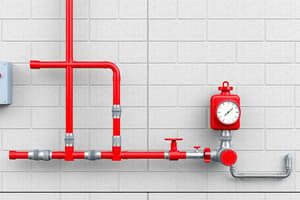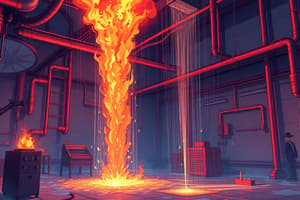Podcast
Questions and Answers
What factor may primarily contribute to the high operating costs of pressurizing water in irrigation systems?
What factor may primarily contribute to the high operating costs of pressurizing water in irrigation systems?
- The volume of water used
- The initial investment cost in infrastructure (correct)
- High electricity prices
- The efficiency of water distribution systems
Which of the following crops is least affected by saline water absorption, according to the suitability analysis?
Which of the following crops is least affected by saline water absorption, according to the suitability analysis?
- Cotton (correct)
- Grapes
- Rice
- Citrus
Which of the following soils is unsuitable for sprinkler irrigation due to low infiltration rates?
Which of the following soils is unsuitable for sprinkler irrigation due to low infiltration rates?
- Silty soil
- Sandy soil
- Clay soil (correct)
- Loamy soil
What percentage yield increase can be expected when irrigation is optimized for Gram compared to traditional methods?
What percentage yield increase can be expected when irrigation is optimized for Gram compared to traditional methods?
When designed properly, which factor is essential for achieving high water application efficiency in sprinkler systems?
When designed properly, which factor is essential for achieving high water application efficiency in sprinkler systems?
What is the primary reason that sprinkler irrigation requires more pressure compared to drip irrigation?
What is the primary reason that sprinkler irrigation requires more pressure compared to drip irrigation?
In which scenario would the use of sprinklers be particularly advantageous for crops?
In which scenario would the use of sprinklers be particularly advantageous for crops?
Which of the following factors does NOT influence the area wetted by a sprinkler?
Which of the following factors does NOT influence the area wetted by a sprinkler?
How does sprinkler irrigation contribute to economic sustainability in agriculture?
How does sprinkler irrigation contribute to economic sustainability in agriculture?
What is the overall efficiency of surface irrigation systems compared to sprinkler systems?
What is the overall efficiency of surface irrigation systems compared to sprinkler systems?
Flashcards
Sprinkler Irrigation Efficiency
Sprinkler Irrigation Efficiency
Sprinkler irrigation system efficiency depends on factors like pressure head at sprinklers, proper spacing, and water quantity applied to match crop needs.
Sprinkler Irrigation Suitability
Sprinkler Irrigation Suitability
Sprinkler irrigation is suitable for various soil types and crops, but not for heavy clay soils with low infiltration rates and specific crops like rice and jute.
Irrigation Water Quality Problems
Irrigation Water Quality Problems
High levels of salt (sodium chloride) and bicarbonates in irrigation water can cause leaf burning and negatively affect fruit quality in various crops.
Water Saving with Sprinkler Irrigation
Water Saving with Sprinkler Irrigation
Signup and view all the flashcards
Crop Yield Increase
Crop Yield Increase
Signup and view all the flashcards
Sprinkler Irrigation
Sprinkler Irrigation
Signup and view all the flashcards
Sprinkler System Components
Sprinkler System Components
Signup and view all the flashcards
Sprinkler Selection Factors
Sprinkler Selection Factors
Signup and view all the flashcards
Sprinkler Irrigation Pressure
Sprinkler Irrigation Pressure
Signup and view all the flashcards
Study Notes
Sprinkler and Micro Irrigation Systems
- Irrigation systems are designed to deliver water to crops.
- Sprinkler irrigation mimics natural rainfall, delivering water as droplets.
- Micro irrigation delivers water directly to the plant roots.
- There are various types of sprinkler systems.
- Sprinkler irrigation is suitable for a variety of crops and soil types.
- Types of sprinkler systems include rotating head, perforated pipe, continuous move (traveling sprinkler, center pivot, boom), and solid set systems.
Contents
- Sprinkler irrigation adaptability and limitations
- Sprinkler classification
- Components of the system
- Sprinkler selection process
- Performance evaluation criteria
Irrigation Efficiencies
- Conveyance efficiency (canal): 40-50%
- Conveyance efficiency (well): 60-70%
- Application efficiency: 60-70% (surface), 70-80% (sprinkler), 90% (drip)
- Surface water moisture evaporation: 30-40%
- Overall efficiency: 30-35% (surface), 50-60% (sprinkler), 80-90% (drip)
Sprinkler Irrigation - What it is?
- Similar to artificial rainfall
- Pressure: 15 m to 40 m
- Suitable for all crops
Sprinkler Irrigation Systems
- Network of pipes and sprinklers
- Pipes supply water at a specific pressure to sprinklers.
- Spraying water is similar to rainfall.
- At the nozzles, pressure converts to velocity resulting in drops of water that distribute like rainfall.
- Area wetted depends upon the water pressure, water jet angle, sprinkler type, and wind conditions during irrigation.
- Sprinkler irrigation needs more pressure than drip irrigation.
Advantages of Sprinkler Irrigation
- Suitable for uneven topography or shallow soil
- Reduces labor costs
- Modifications to weather extremes (e.g. increasing humidity)
- Frost removal when deposited on the foliage
- Efficient pesticide application
- High application efficiency (typically 80% or above)
Disadvantages of Sprinkler Irrigation
- High investment costs
- High operating costs for pressurizing water
- Saline water can damage certain crops.
- If sodium levels are above 70 ppm or chloride levels are above 105 ppm, leaf burning problems may occur in some crops.
- Issues with uneven distribution due to windy conditions
- Poor infiltration in certain soil types (e.g. clay) can lead to runoff.
- Issues with irregular shaped fields can impact spacing of sprinklers.
Types of Sprinkler Irrigation Systems
- Set System: Pipes & sprinklers remain fixed.
- Continuous Move System: Sprinkler system moves while irrigating (traveling sprinkler, center pivot, boom).
- Traveling Sprinkler: Flexible hose, reel-based.
- Center Pivot: Sprinkler heads on a rotating truss.
- Boom Type: Truss moves linearly rather than rotating.
- Solid Set: Laterals positioned early in the season.
- Periodic Move System: Manually or mechanically moving components between irrigation cycles (portable, semi-portable).
Sprinkler Irrigation System Performance
- System efficiency depends on the pressure head at the sprinklers, proper spacing based on soil type and crop and wind conditions.
- The quantity of water to be applied can be regulated to match the crops' water requirements.
- Irrigation can achieve high application and water distribution efficiencies.
Response of Different Crops to Sprinkler Irrigation
- Data in chart form showcasing water savings and yield increases for various crops under sprinkler irrigation.
Adaptability of Sprinkler Irrigation
- Suitable for most soil types and topographies.
- Not suitable for heavy clay soils with low infiltration rates.
- Works best for sandy soils with high infiltration rates.
- Land levelling is often not essential.
- Often significantly reduces labor needs for irrigation applications.
- Useful for shallow soils which are problematic for other irrigation methods, especially on slopes and uneven terrains.
Sprinkler Irrigation System Classification
- Spraying arrangement basis (rotating/perorated pipe)
- Portability basis (periodic/continuous/permanent)
- Nozzle basis (single/twin nozzle)
- Spray volume basis (micro/mini/large volume)
Sprinkler Heads
- Single nozzle or twin nozzle
- Smaller diameter nozzles for smaller wetted areas or larger diameter for larger wetted areas
- Impact sprinklers - rotate using water impact on a rocker arm
Components of Sprinkler Irrigation System
- Pump (at water source), Filter(s), Fertilizer applicators (as required), Non-return valves, Bypass Valves, Water Meter (optional), Control Valves, Pressure Gauge, Delivery Pipes, Laterals, Sprinkler heads, fittings.
Water Sources - Pumping Sets
- Pumps lift water and push it through the distribution system.
- Pumps should be designed to lift water to the highest field point for sufficient operating pressure.
Pumps
- Volute centrifugal pumps
- Deep well turbine pumps
- Submersible pumps
- Centrifugal pumps are commonly used if the water source is an open well, river, canal or pond.
- Booster pumps are centrifugal type
- Turbine pumps used to pump from deep tubewells
Pipes
- Aluminum or HDPE pipes.
- HDPE pipes are gaining prominence due to cost advantage.
- Available in 3 and 6 meter lengths.
- Pipe strength defined by maximum pressure.
- Mostly 75mm diameter pipes are used in India
Pipe Fittings
- End caps, tees, bends
- Sprinkler heads are mounted on risers which are typically fixed at 1m height
- Fittings (flanges, couplings, nipples, bends, tees, reducers, elbows, hydrants, butterfly valves, plugs), are a vital part of the system for easier and safer connections.
- Quick release couplers for faster connections and disconnections
- Pipes fittings are important for smooth water flow within the sprinkler irrigation system.
Raiser Pipes
- Used for fixing sprinklers at specified heights (0.3m to 1m).
- Made of aluminum or PVC stakes, based on the system type.
Other Accessories
- Water meters for measuring water delivery volume
- Pressure gauges for monitoring pressure uniformity
Questions and Answers (Q&A)
- True/False questions about sprinkler systems.
- Choices of incorrect statements referring to sprinkler system attributes.
Studying That Suits You
Use AI to generate personalized quizzes and flashcards to suit your learning preferences.




